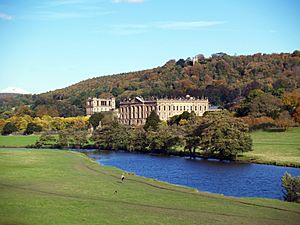William Cavendish (courtier) facts for kids
Quick facts for kids
William Cavendish
|
|
|---|---|

Sir William Cavendish c. 1547
|
|
| Born | c. 1505 |
| Died | 25 October 1557 |
| Nationality | English |
| Occupation | Politician, knight, courtier |
| Title | Sir |
| Spouse(s) | Margaret Bostock (1st), Elizabeth Parker (2nd), Bess of Hardwick (3rd) |
| Children | 16 (including William Cavendish, 1st Earl of Devonshire, Elizabeth Stuart, Countess of Lennox, and Mary Talbot, Countess of Shrewsbury) |
| Parent(s) | Thomas Cavendish Alice Smith |
| Relatives | Sir John Cavendish (great-grandfather) |
Sir William Cavendish (born around 1505, died 25 October 1557) was an important English politician. He was also a knight and a courtier, which means he served in the royal court. William Cavendish held many public jobs and became very wealthy.
He was one of the people who helped Thomas Cromwell during the time when King Henry VIII closed down many monasteries. This event is known as the dissolution of the monasteries. In 1547, William Cavendish became a MP for Thirsk. That same year, he married Bess of Hardwick, a very famous and smart woman. Together, they started building Chatsworth House in 1552. This grand house was finished after his death. His son, also named William Cavendish, later became the first Earl of Devonshire.
Contents
Who was William Cavendish's family?
William Cavendish was the younger son of Thomas Cavendish. His father was a senior financial official in the government. His mother was Alice Smith.
The Cavendish family was quite old and well-known. William was a distant grandson of Sir John Cavendish. The family name Cavendish was later passed down to important families like the Dukes of Devonshire.
What did William Cavendish do in his career?
William Cavendish was very good with money. He worked in the Exchequer, which was like the government's finance department. This job helped him become very rich.
Helping with the Dissolution of Monasteries
King Henry VIII decided to take over the property of the Catholic Church in the late 1530s. This was called the dissolution of the monasteries. William Cavendish became one of Thomas Cromwell's "visitors of the monasteries." These visitors helped to close down the monasteries and take their wealth for the King.
After Thomas Cromwell lost his power, William Cavendish was sent to Ireland. His job there was to check and value lands that the English had taken during a rebellion.
Working for the Royal Court
William Cavendish was connected to important people in the royal court. He worked closely with the Seymour brothers, Edward and Thomas. He also made sure to stay on good terms with Lady Mary, who later became Queen Mary I.
From 1546 to 1553, he was the Treasurer of the Chamber. This meant he managed the royal household's money. After his death, there were questions about some of the money he handled.
Who wrote about Thomas Wolsey?
For a long time, people thought William Cavendish wrote a famous book about Thomas Wolsey. Wolsey was a powerful cardinal who served King Henry VIII. The book was written by someone who knew Wolsey very well. However, historians now believe it was William's older brother, George Cavendish, who wrote the book.
Who was in William Cavendish's family?
William Cavendish had a large family, with 16 children from three different wives.
First Marriage
His first wife was Margaret Bostock. They had five children together. However, only three of their daughters lived to adulthood:
- Catherine, who married Thomas Brooke.
- Mary (who died after 1547).
- Ann, who married Sir Henry Boynton in 1561.
Second Marriage
In 1542, he married Elizabeth Parker. They had three children, but sadly, none of them survived. Elizabeth died in 1546 after giving birth to a baby who did not live.
Third Marriage to Bess of Hardwick
In 1547, William Cavendish married Bess of Hardwick. This was a very important marriage for him. He sold his property in Suffolk and moved to Bess's home county of Derbyshire.
In 1549, he bought the Chatsworth estate. Then, in 1552, he and Bess began building the famous Chatsworth House.
They had eight children together in the ten years before he died. Six of these children survived childhood:
- Frances Cavendish (1548–1632), who married Henry Pierrepont.
- Henry Cavendish (1550–1616), their oldest son. He was a Member of Parliament for over 20 years.
- William Cavendish (1552–1626), who became the first Earl of Devonshire.
- Charles Cavendish (1553–1617), who was the father of William Cavendish, the first Duke of Newcastle.
- Elizabeth Cavendish (1555–1582). She married Charles Stuart, the Earl of Lennox. Their daughter, Arbella Stuart, was a claimant to the English throne.
- Mary Cavendish (1556–1632), who married Gilbert Talbot, the seventh Earl of Shrewsbury.


